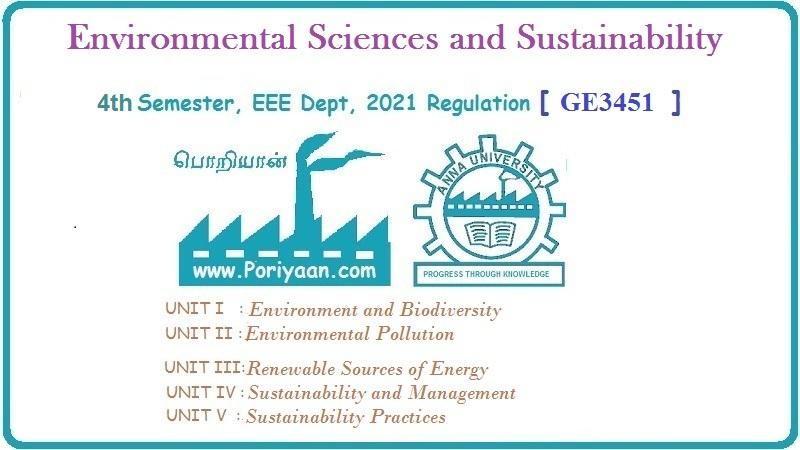Environmental Sciences and Sustainability: Unit V: Sustainability Practices
Two Marks Questions with Answers
Environmental Sciences and Sustainability | Sustainability Practices
Environmental Sciences and Sustainability: Unit V: Sustainability Practices : Two Marks Questions with Answers
Two Marks Questions with Answers
Q.1
What is e-waste ?
Ans.
: E-Waste :
•
The term "e-waste" is an abbreviation of electronic waste.
•
E-Waste is a term used to cover items of all types of electrical and electronic
equipment (EEE) and its parts that have been discarded by the owner as waste
without the intention of re-use.
•
E-waste is a general term, it can be considered to denote items such as TV
appliances, computers, laptops, tablets, mobile phones, white goods - for
example, fridges, washing machines, dryers - home entertainment and stereo
systems, toys, toasters and kettles.
Q.2
Write the concept of Green building.
Ans.:
•
A Green building focuses on increasing the efficiency of resource use - energy,
water and materials - while reducing building impact on human health and the
environment during the building's lifecycle, through better sitting, design,
construction, operation, maintenance and removal.
•
Green buildings should be designed and operated to reduce the overall impact of
the built environment on its surroundings.
•
Green buildings are designed to reduce the overall impact of the built
environment on human health and the natural environment by :
1.
Efficiently using energy, water and other resources.
2.
Protecting occupant health and improving employee productivity.
3.
Reducing waste, pollution and environmental degradation.
Q.3
What is ozone depletion ?
Ans.
:
Ozone depletion : Breakdown of the ozone shield (a thin layer of ozone gas
molecules in the atmosphere) that can absorb damaging ultraviolet radiation and
have major implications for global weather ; CFCs and halons greatly speed the
process.
Q.4
List out any four environmental protection acts.
Ans.
: 1.
Air (Prevention and control of pollution) Act.
2.
Water (Prevention and control of pollution) Act.
3.
Forest censervation Act.
4.
Environmental lows.
Q.5
What are the major effect of global warming ?
Ans.:
Effects of global warming :
1.
Changes in climate.
2.
Effect on agriculture productivity.
3.
Effect on water resources.
Q.6
List out the objective of EIA.
Ans.:
Objectives of EIA :
1.
To identify the reasons of problem.
2.
To identify the problems and issues of the parties.
3.
To identify the affected parties.
Q.7
Mention the effects of ozone on plants.
Ans.
: Effects of ozone on plants
1.
Ozone enters through openings into the leaf and damage the cells that produce
the food for the plant.
2.
Once the ozone is abserbed into the leaf, plants may suffer from toxic effect
and growth loss exists.
Q.8
Define EIA and its benefits.
Ans.
:
Environmental Impact Assessment (EIA) is the process of assessing the likely
environmental impacts of a proposal and identifying options to minimise
environmental damage.
Benefits
of EIA :
1
EIA gives basis for better decision making.
2.
EIA provides potential environmental effects.
3.
Helps in formulation of projects.
Environmental Sciences and Sustainability: Unit V: Sustainability Practices : Tag: : Environmental Sciences and Sustainability | Sustainability Practices - Two Marks Questions with Answers
Related Topics
Related Subjects
Environmental Sciences and Sustainability
GE3451 ESS 4th Semester | 2021 Regulation | 4th Semester EEE Dept 2021 Regulation
